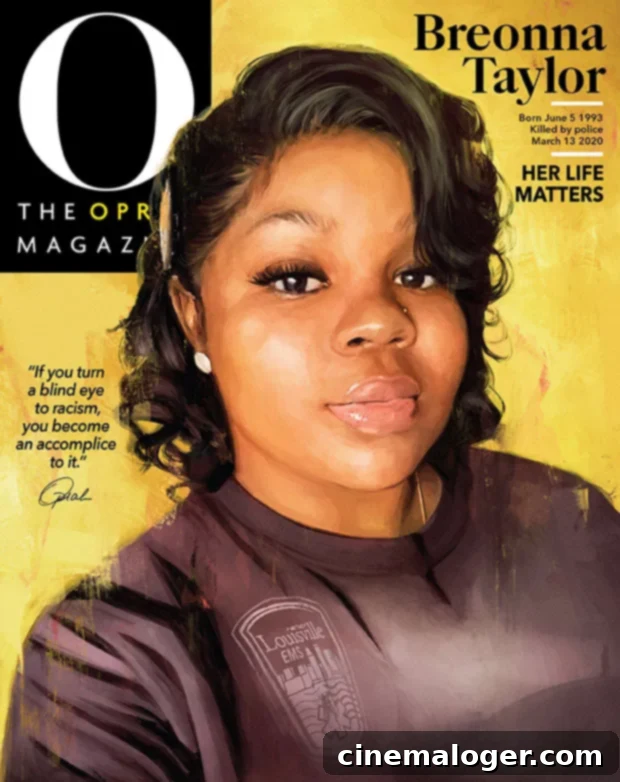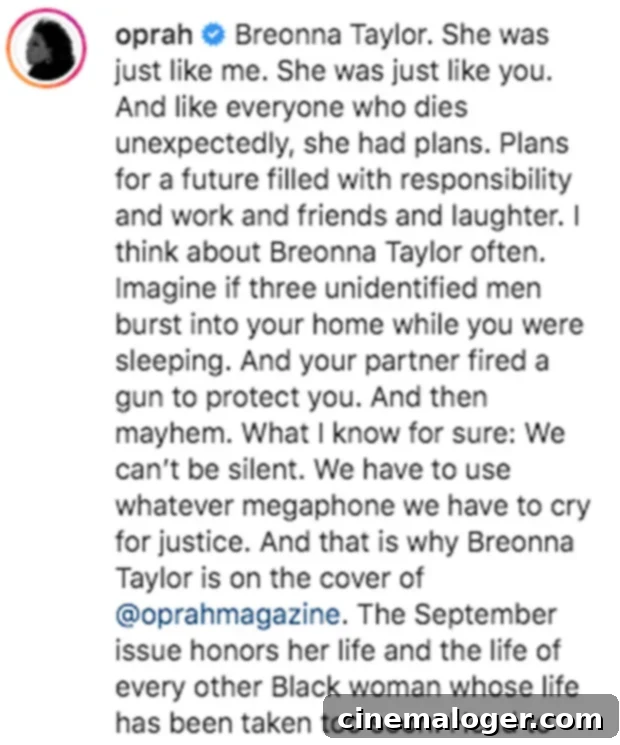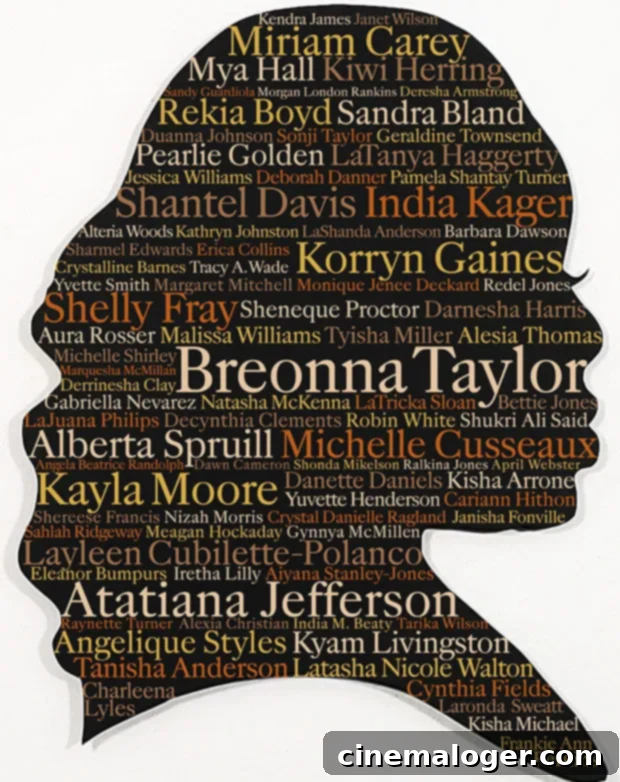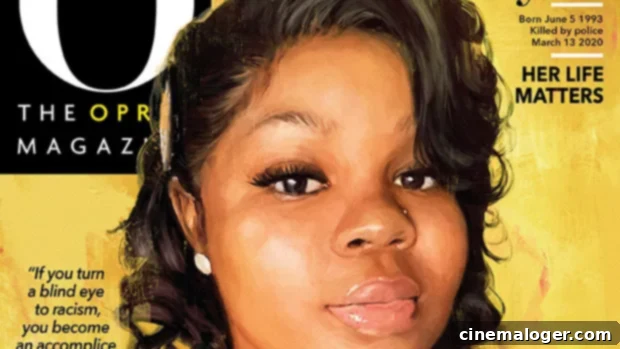Oprah Winfrey Honors Breonna Taylor: A Powerful Call for Justice on O Magazine Cover
In a groundbreaking and deeply moving tribute, media icon Oprah Winfrey dedicated the September issue of O Magazine to Breonna Taylor, a 26-year-old Black emergency medical technician whose life was tragically cut short by police violence. This marked a historic moment for the publication, as Taylor became the first person other than Oprah herself to grace the cover in the magazine’s two-decade history. The decision underscored Oprah’s unwavering commitment to amplifying voices and fighting for justice, sending a powerful message that “we can’t be silent” in the face of such profound loss and systemic injustice.
Over four months after her tragic death, Breonna Taylor’s image, rendered in a stunning digital portrait by talented artist Alexis Franklin, was unveiled on July 30, 2020. Oprah herself took to her Instagram account to share the poignant cover and an inspiring message with her millions of followers. The image captured Taylor’s serene yet resolute gaze, bringing her face and story to the forefront of a national conversation that urgently demanded attention and action. This cover was not merely an aesthetic choice; it was a deliberate and impactful statement, transforming a fashion and lifestyle magazine into a platform for vital social commentary and advocacy.

“Breonna Taylor. She was just like me. She was just like you. And like everyone who dies unexpectedly, she had plans,” Oprah began the caption to her Instagram post. These words immediately established a profound sense of kinship and shared humanity, compelling readers to see Breonna not as a statistic, but as an individual with dreams, aspirations, and a future brutally stolen. The media mogul confessed that, in those tumultuous times, she thought “about Breonna Taylor often.” She also meticulously chronicled for her followers the tragic events of March 13, 2020, when 26-year-old Breonna was fatally shot in her sleep by Louisville Metro Police Department officers Jonathan Mattingly, Brett Hankison, and Myles Cosgrove. Despite the severity of the incident and the widespread outrage it sparked, only one officer, Brett Hankison, had been fired at that time, with no charges filed against any of the officers directly involved in her death. This stark reality served as a painful reminder of the systemic failures and the urgent need for accountability.
Oprah’s message resonated deeply, serving as a powerful call to action for collective responsibility. “What I know for sure: We can’t be silent,” Oprah urged those reading her caption. “We have to use whatever megaphone we have to cry for justice. And that is why Breonna Taylor is on the cover of Oprah Magazine. The September issue honors her life and the life of every other Black woman whose life has been taken too soon.” This declaration underscored the magazine’s shift from a purely editorial platform to one deeply engaged in the fight for social equity. By featuring Breonna Taylor, Oprah not only honored a specific individual but also acknowledged the broader pattern of violence and injustice faced by Black women, whose stories too often remain untold or overshadowed.

Beyond the incredible cover, Oprah further honored Breonna Taylor in a deeply personal and eloquent essay within the magazine, reflecting on the phenomenal life that was lost. “Breonna Taylor had plans. Breonna Taylor had dreams. They all died with her the night five bullets shattered her body and her future,” she wrote. Her words painted a vivid picture of a promising young woman, an EMT dedicated to helping others, whose life was violently interrupted. Oprah drew a poignant parallel, noting that Breonna was the same age as the two “daughter-girls” from her school in South Africa who had been quarantining with her and Stedman Graham since March. “In all their conversations I feel the promise of possibilities,” Oprah shared, highlighting the stark contrast between the vibrant future she envisioned for her students and the abrupt end to Breonna’s potential.
Oprah eloquently wrote about how the lives of the young Black women she knows “shine with the light of hopefulness,” and how that very same light “was taken away from Breonna in such a horrifying manner.” This reflection deepened the emotional impact, transforming Breonna’s story into a symbol of the extinguished potential within the Black community due to systemic violence. In the weeks and months that followed Breonna’s death at the hands of law enforcement, American citizens and global communities turned their attention to the deaths of other Black citizens, such as George Floyd, killed on May 25, 2020, and Ahmaud Arbery, who was killed on February 23, 2020. These cases, occurring in rapid succession, ignited a fierce and widespread outcry against racial injustice and police brutality, galvanizing a movement for change.

Millions across the globe came out to protest police brutality and racial injustice, demanding accountability and systemic reform in the wake of the violent deaths of these and many other Black citizens. Public mourning and emotional funerals also took place to remember George Floyd’s life, who was killed when officer Derrick Chauvin knelt on George’s neck for nearly nine minutes, a horrifying act captured on video that sparked global condemnation. All four officers involved in George Floyd’s death were eventually charged, a crucial step towards justice that starkly contrasted with the initial lack of charges in Breonna Taylor’s case. These protests were not merely fleeting moments of anger; they represented a sustained global movement, Black Lives Matter, calling for fundamental changes to policing, an end to qualified immunity, and a recognition of the inherent value of Black lives.
With this powerful issue of her magazine, Oprah was not only honoring and remembering Breonna Taylor but also drawing attention to the many lives of Black women whose lives were cut far too short by police brutality and societal neglect. Oprah delved into a profound historical connection, describing her collection of property ledgers from former plantations, which meticulously detailed the names of Black women bound in slavery. “As a great-great-granddaughter of enslaved people, I know that in a different era my name would have been in someone’s ledger,” she noted, creating an undeniable link between past injustices and present-day realities. This personal connection imbued her message with an even greater sense of urgency and authenticity.
“Those ledgers come to mind when I see the names of Black women who were killed by police. Breonna Taylor and too many others like her. I see the names, I think of the ledgers, I feel the connection down the generations: the refusal to value Black women’s lives. And I feel a personal connection. Because I am these women. These women are me.” These powerful words articulated the generational trauma and the persistent systemic devaluation of Black women. Oprah’s declaration transcended individual grief, transforming it into a collective outcry against historical and ongoing oppression. Her stance served as a reminder that the fight for justice for Breonna Taylor is inextricably linked to a broader struggle for human dignity and equality for all Black women, past and present. The September issue of O Magazine, with Breonna Taylor’s image on its cover, stands as a testament to the power of media to drive conversation, inspire action, and demand that silence no longer be an option in the face of injustice.
